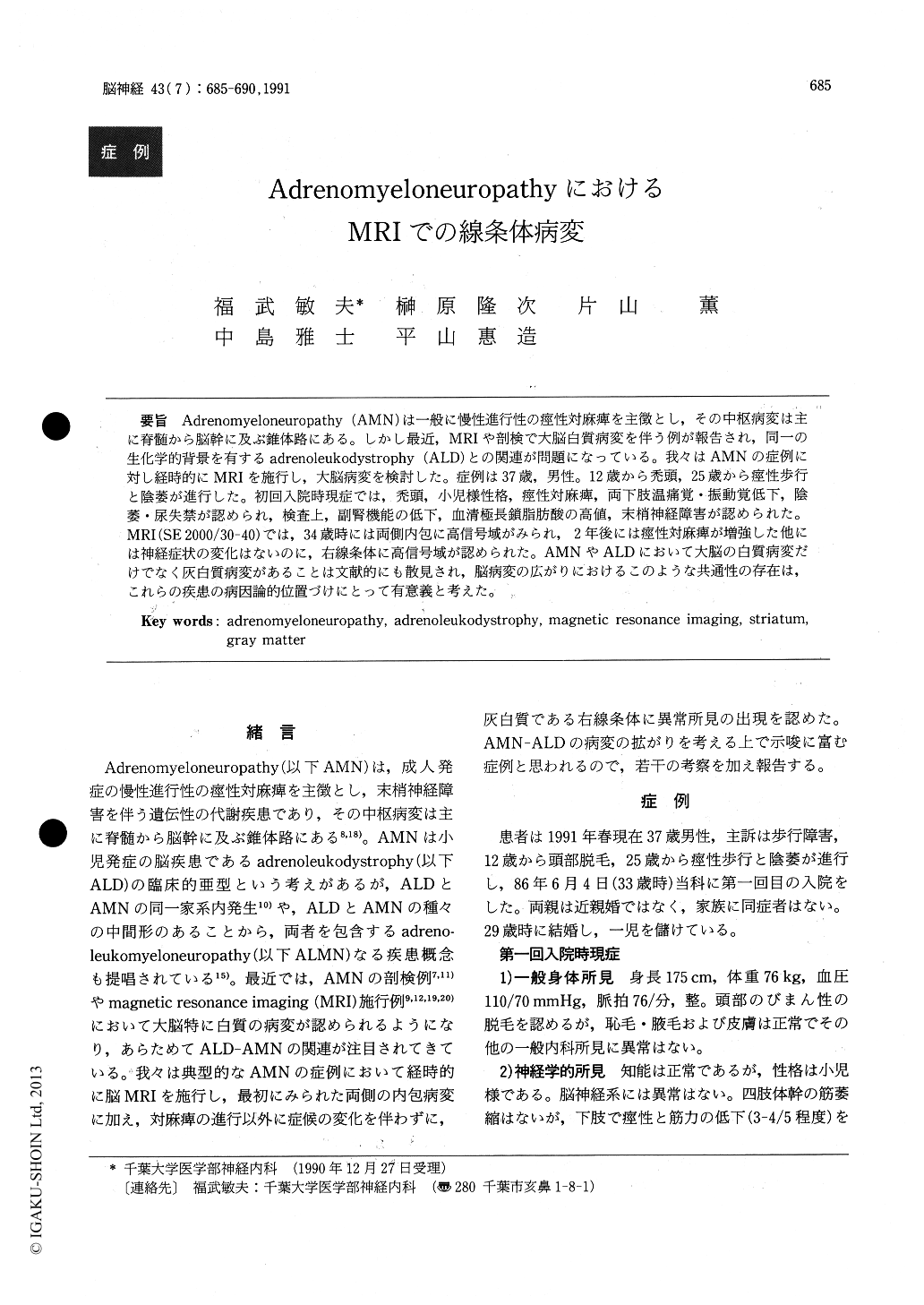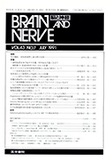Japanese
English
- 有料閲覧
- Abstract 文献概要
- 1ページ目 Look Inside
Adrenomyeloneuropathy(AMN)は一般に慢性進行性の痙性対麻痺を主徴とし,その中枢病変は主に脊髄から脳幹に及ぶ錐体路にある。しかし最近,MRIや剖検で大脳白質病変を伴う例が報告され,同一の生化学的背景を有するadrenoleukodystrophy(ALD)との関連が問題になっている。我々はAMNの症例に対し経時的にMRIを施行し,大脳病変を検討した。症例は37歳,男性。12歳から禿頭,25歳から痙性歩行と陰萎が進行した。初回入院時現症では,禿頭,小児様性格,痙性対麻痺,両下肢温痛覚・振動覚低下,陰萎・尿失禁が認められ,検査上,副腎機能の低下,血清極長鎖脂肪酸の高値,末梢神経障害が認められた。MRI(SE2000/30-40)では,34歳時には両側内包に高信号域がみられ,2年後には痙性対麻痺が増強した他には神経症状の変化はないのに,右線条体に高信号域が認められた。AMNやALDにおいて大脳の白質病変だけでなく灰白質病変があることは文献的にも散見され,脳病変の広がりにおけるこのような共通性の存在は,これらの疾患の病因論的位置づけにとって有意義と考えた。
Adrenomyeloneuropathy (AMN), a clinical vari-ant of child adrenoleukodystrophy (ALD) , is an adult-onset progressive disorder which presents spastic paraparesis with peripheral nerve involve-ment and affects mainly the pyramidal tracts from the brainstem to the spinal cord.We report a case of AMN in which serial MRI showed unusual develop-ment of areas of high signal in the right striatum.
The patient was in good health until the age of 12, when he began to lose his hair. At age 25 he started to have progressive gait disturbance and erectile impotence. In his first admission to our hospital at age 33, he showed diffuse baldness. He was intelli-gent but childish. His cranial nerves were normal. Muscle strength was weak (3-4/5) in the lower extremities. Deep tendon reflexes were hyperactive in the lower extremities while normal in the upper extremities. Babinski signs were elicited bilaterally. Pinprick and vibratory sensation was impaired in the lower legs. Proprioceptive sensations were nor-mal. Co-ordination was intact. There were urinary incontinence and impairment of erection with preserved libido and ejaculation. Routine laboratory data including hematological studies, serum chemis-try and urinalysis were all normal except for mild hyperlipidemia. Serum cortisol response to ACTH was low and serum levels of very long chain fatty acids were increased. Nerve conduction studies were abnormal and consistent with peripheral polyneuropathy. A biopsy specimen of left sural nerve revealed a mild loss of myelinated fibers with thinning of the myelin. These findings and the clini-cal features confirmed the diagnosis of AMN.
MRI in SE2000/40 scans at age 34 disclosed areas of high signal in the bilateral internal capsules. Serial MRI re-examination, 2 years later at his second admission, showed areas of high signal within both the right striatum from the caudate head to the putamen and the internal capsules, although he had presented no newly-developed obvi-ous neurological signs and symptoms other than slight progression of spastic paraparesis from thefirst MRI study. A CT scan revealed low attenuation areas with contrast enhancement in the right striatum corresponding to the high signal regions on MRI.
Gray matter involvement in AMN has been believed to be rare both radiologically and path-ologically as well as in ALD except for in the termi-nal stage. Some authors, however, reported several cases of AMN or ALD with lesions in the gray matter, such as the caudate head, thalamus and putamen, on MRI or at autopsy. Although AMN differs clinically from ALD, both could have cere-bral gray matter disease as well as white matter disease and a sequential study of MRI is essential for demonstrating the broad and various expres-sions of AMN/ALD.

Copyright © 1991, Igaku-Shoin Ltd. All rights reserved.


